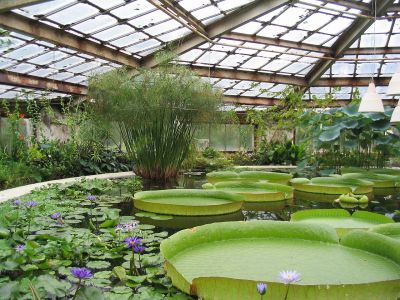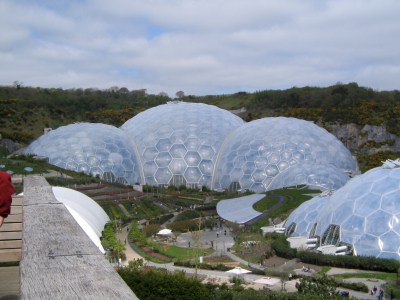Think of a greenhouse. It’s a structure with glass walls that lets light in and traps heat, all for the benefit of the plants inside. As for how it works, that’s elementary! It’s all down to the greenhouse effect… right?
Alas, no. So many of us have been mislead. Let’s rexamine how we think greenhouses work, and then explore what’s actually going on.
Green Me Up Scotty

While it’s true that greenhouses create a controlled environment conducive to plant growth, the science behind how they work is a tale often mistold. It all comes down to misconceptions around the greenhouse effect.
In reality, the greenhouse effect is not how greenhouses work at all. Instead, it’s an analogy we use to help explain the concept of the Earth retaining additional heat from sunlight. In the case of our planet, sunlight comes to Earth, and a great deal of that is shortwave radiation—visible light. Much of that light is absorbed by the Earth and reradiated as longer-wavelength infrared radiation. So-called “greenhouse gases” in Earth’s atmosphere capture that infrared radiation rather than letting it float back off into space. The higher the concentration of greenhous gases in the atmosphere, the more heat is trapped, and Earth warms up as a result. The “greenhouse effect”.

The naming of the greenhouse effect has led many to assume that greenhouses work the same way. After all, greenhouses are full of plants that absorb sunlight, right? And some of that is re-radiated as heat. Further supporting the idea is the fact that greenhouses are traditionally made of glass. Glass tends to absorb infrared radiation rather than letting it pass through—much like greenhouse gases in our atmosphere! It all makes sense!
And yet, that’s not how greenhouses really work at all. The tell is that you can build a greenhouse out of polyethylene. Unlike glass, polyethylene is quite transparent to the thermal wavelengths of infrared. If greenhouses relied on trapping infrared radiation for warmth, they wouldn’t work with the plastic at all. But they do!
Greenhouses aren’t really about radiation at all. Instead, they’re all about controlling convection instead.
Picture a bare patch of ground. As the sun shines on it, it heats up. The warm ground in turn heats up the air above it. The warmer air expands and becomes less dense, and rises up from the ground. It’s replaced by cooler air which again saps heat from the ground and through convection, carries away more heat in turn. In some cases, this effect can create a large rising column of warm air called a thermal—which is often enjoyed by gliders, hang gliders, and several species of birds.

Now picture that same patch of ground, but there’s a greenhouse sitting on top of it. The greenhouse and the ground warm up by the heat of the sun. However, this time, the air can’t go anywhere. The air trapped in the greenhouse keeps picking up energy from the sun all day, and from the ground at night. Without being able to flow anywhere, all that heat is trapped by the walls of the greenhouse. Thus, the greenhouse becomes warmer, and stays warmer, than the surrounding air. It’s all about preventing convection, not blocking radiation.
Airflow, or the lack of it, is key to how a greenhouse works. In fact, to control temperature in a greenhouse, ventilation is vital. It’s also important for regulating humidity and ensuring a supply of fresh air for photosynthesis of the plants inside. To this end, many greenhouses feature roof vents, side vents, and fans to expel excess heat and moisture and to draw in cooler, drier air when necessary.
Of course transparency still plays a role in the greenhouse. It allows the sun’s rays to penetrate the building and be absorbed by the plants inside. This is key for photosynthesis, and for raising the internal temperature in the first place.
It’s interesting how the simple choice of name for a widely-understood environmental effect could so skew the common understanding of how greenhouses work. The misconception obviously is further supported by the fact that it sounds right, but as we all know—in science, sounds right is rarely the same as actually right.
You can now use this nifty misconception as your go to “well actually…” fact when you’re trying to be annoying at a dinner party. You’re welcome!

















Fascinating topic, isn’t?
At night and even before sunset heat transmission in the format of long wave radiation from the bottom of the greenhouse towards the roof play a significant role in the plants temperature.
When measuring with a Sigrow net-radiometer heat radiation losses can reach 100W/m2 from plants canopy to the cold greenhouse roof. This can drive plants leaves temperature too close to dew point with the potential condensation risk.
If someone is interested in an open source model for greenhouses I leave you one here
https://github.com/davkat1/GreenLight
Can we then say it’s better to use plastic instead of glass as it insulate better and avoids condensation after sunset? That’s a good reason to choose a plastic greenhouse.
pedantic
“greenhouse effect” was,and,is an analogy to help
explain an invisible phenominon to non scientists,
not in itself science,and so not in need of disproving
We all know, but it’s still an interesting fact that the thermal processes differ. And pedantic people are annoying at dinner parties, we know, but we just can’t help ourselves ;)
The moral of the story should be: “Never fly your hand glider over a glasshouse”
Hand gliding, done out of a car window at speeds where you can feel the forces. You’ll cut your hand on the glass shards if done over a greenhouse.
Then to extend this farther, how was the environment maintained in the domed city in Logan’s Run ? It must have had a macro climate of its own. I have heard of clouds forming in the VAB (Vertical Assembly Building) at the space center so they must have had the same problem. Then would we be able to construct and live in a domed city the same size ? Just a thought…
Simple answer: It was in the script.
I will overthink sci-fi if I damn well want to buddy. I will pull your “no fun allowed” sign out of the ground and toss it
Ok now you’ve brought up movies, I will raise you: Bio-Dome 1996 an excellent movie about greenhouses. Even if wikipedia says it is one of the worst movies ever made.
I am about to build a greenhouse myself soon so thanks for this post.
“he higher the concentration of greenhous gases in the atmosphere, the more heat is trapped, and Earth warms up as a result.”
Sabine Hossenfelder had a video about it and this seems to be more complex than that. Unfortunately my goldfish memory recalls only something about “stratospheric cooling”.
The difference is more towards longevity than anything else. Best I’ve done is 4 years between covering replacement when i use plastic. Glass will last much longer if you can tolerate the UV losses
meh. no. this is hogwash. the greenhouse effect is when heat can get in but struggles to get out. the mechanism is different in different scenarios but the fact that you’re more likely to hear it in headlines referring to earth as a whole doesn’t redefine the word.
it’s not just pedantic, it’s assuming the phrase was hijacked. but the words are perfectly obvious from their dictionary definitions. the use as jargon doesn’t supplant those definitions, it extends them. the greenhouse effect is the thing that keeps greenhouses warm: a net imbalance in energy transfer.
i really hate when an article tries to present an introductory lecture as if it was obscure or counter. it’s not counter. it’s just an introductory lecture.
I have met a great many people who think the greenhouse effect means that glass structures work primary by trapping radiation.
You’re both right!
Earth loses heat by radiating, the ground/plants lose heat by conducting/convecting. So on some level, the “effect” is the same — a one-way heat valve.
But many people _do_ think that greenhouses work by trapping down-converted IR.
And with that, I’ve summarized the article. :)
Just maintaining the humidity will ensure a greater thermal mass within the structure’s volume. It is about the water vapor, always was and always will be, because water goes through phases changes across the temperature range that supports life on Earth.
just came to comment on thermal mass. Paint tanks of water black, heats during the day, slowly releases into the convection oven at night. On a larger scale, massive parking lots perform a similar function, but without the dome. This is what always bothers me about the scifi end of the world “we’ll build bio domes”.
Some (hippy) friends of mine did this back in the day: black water barrels on their windowed-in porch. It was amazingly effective, and provided a very comfy heat through Nashville’s fairly mild winters. It’s stuck with me.
“ensuring a supply of fresh air for photosynthesis” actually no they have CO2 sources for that so that they can create the elevated levels that maximise production for any given crop, because they do vary in their requirements, but as a general rule they all benefit from higher than ambient levels of CO2.
It’s not one-sided. Sometimes people say lower CO2 levels and slower growth can produce better quality (nutrition, flavor).
So by this logic the Greenhouse with plastic sheeting should get colder than the surroundings at night due to the escape of interior heat via IR radiation through the plastic and the trapped air inside. Free refrigeration?
+1 learned something today, even more in English which is not my mother language. Thought the material of the green house (grass vs polymer) didn’t matter, but turns out it does.